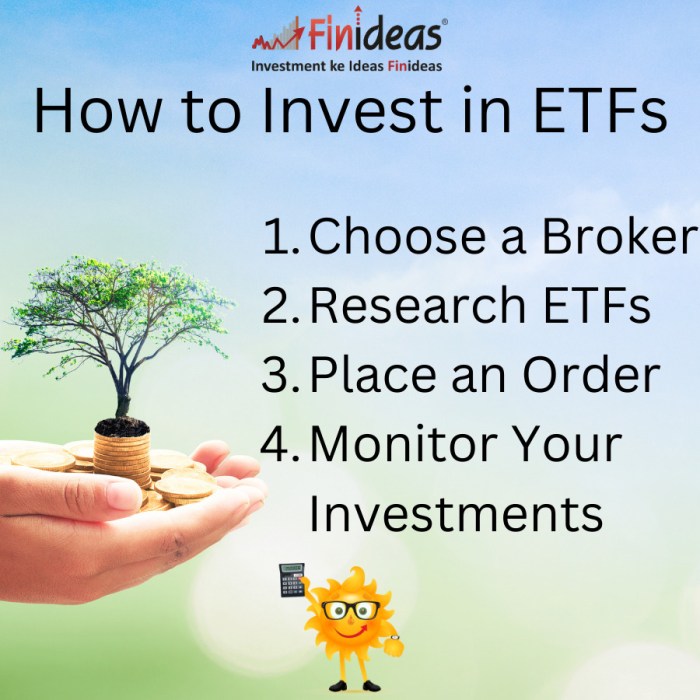How to invest in ETFs, a popular investment option, offers a diverse range of opportunities for investors looking to build a well-rounded portfolio. From understanding the basics to selecting the right ETFs, this guide will walk you through the essential steps to start investing in ETFs effectively.
Whether you’re a seasoned investor or just starting, mastering the art of ETF investing can provide you with a solid foundation for long-term financial growth.
Introduction to ETFs

Exchange-Traded Funds (ETFs) are investment funds that are traded on stock exchanges, similar to individual stocks. However, unlike individual stocks, ETFs hold a diversified portfolio of assets such as stocks, bonds, or commodities.
Investing in ETFs offers several benefits compared to other investment options. One of the key advantages is diversification, as ETFs provide exposure to a wide range of assets within a single investment. This diversification helps reduce risk compared to investing in individual stocks.
Popular ETFs and Performance
Some popular ETFs include SPDR S&P 500 ETF Trust (SPY), which tracks the performance of the S&P 500 index, and Invesco QQQ Trust (QQQ), which focuses on the Nasdaq-100 Index. These ETFs have shown consistent performance over time, mirroring the performance of the underlying indices they track.
Types of ETFs
When it comes to ETFs, investors have a variety of options to choose from based on their investment objectives and risk tolerance. Here, we will discuss the different types of ETFs available and their unique characteristics and investment strategies.
Market Index ETFs
Market index ETFs are designed to track a specific stock market index, such as the S&P 500 or the NASDAQ. These ETFs provide investors with exposure to a broad market segment or specific industry without having to purchase individual stocks.
- Characteristics: Market index ETFs aim to replicate the performance of the underlying index by holding a diversified portfolio of securities.
- Investment Strategy: Investors can use market index ETFs to gain broad market exposure or to implement a passive investing strategy.
- Risk and Return Profile: Market index ETFs typically offer moderate risk with the potential for steady returns over the long term.
Sector ETFs
Sector ETFs focus on specific industry sectors, such as technology, healthcare, or energy. These ETFs allow investors to target their investments in a particular sector that they believe will outperform the broader market.
- Characteristics: Sector ETFs concentrate on a specific industry or sector, providing investors with targeted exposure to that segment of the market.
- Investment Strategy: Investors can use sector ETFs to capitalize on the growth potential of a specific industry or to hedge against sector-specific risks.
- Risk and Return Profile: Sector ETFs carry higher risk compared to market index ETFs but also offer the potential for higher returns if the chosen sector performs well.
Bond ETFs
Bond ETFs invest in a diversified portfolio of fixed-income securities, such as government bonds, corporate bonds, or municipal bonds. These ETFs provide investors with exposure to the bond market and can be used to generate income or add diversification to a portfolio.
- Characteristics: Bond ETFs hold a variety of fixed-income securities with different maturities and credit qualities to provide diversification and income potential.
- Investment Strategy: Investors can use bond ETFs to earn regular interest income, preserve capital, or hedge against equity market volatility.
- Risk and Return Profile: Bond ETFs are generally considered lower risk compared to equity ETFs but offer lower potential returns. The risk and return profile can vary based on the types of bonds held in the ETF.
How to Choose ETFs
When it comes to selecting ETFs for your investment portfolio, there are several factors to consider to ensure you make informed decisions. From expense ratios to diversification, each aspect plays a crucial role in the success of your investments. Let’s delve into the key considerations when choosing ETFs.
Factors to Consider when Selecting an ETF
- Expense Ratio: One of the most important factors to consider is the expense ratio of the ETF. This is the annual fee charged by the fund manager for managing the ETF. A lower expense ratio means more of the returns are retained by the investor.
- Liquidity: Liquidity refers to how easily you can buy or sell shares of the ETF on the market. Higher liquidity ensures that you can enter and exit positions without significant impact on the price.
- Tracking Error: Tracking error measures how closely the ETF follows its underlying index. A lower tracking error indicates that the ETF is effectively mirroring the index performance.
Importance of Diversification through ETFs
Diversification is key to reducing risk in your investment portfolio. ETFs provide a convenient way to achieve diversification by investing in a basket of securities across different industries, sectors, or regions. This helps spread risk and minimize the impact of volatility in any single asset.
Tips on Researching and Evaluating ETFs
- Understand the Index: Before investing in an ETF, make sure you understand the underlying index it tracks. Different indices focus on various sectors, markets, or strategies, so choose one that aligns with your investment goals.
- Look at Performance: Analyze the historical performance of the ETF to gauge how it has performed over time. Compare its returns to the benchmark index to assess its effectiveness in tracking the market.
- Check Holdings: Review the holdings of the ETF to see what assets it invests in. Ensure the holdings align with your risk tolerance and investment objectives.
Investing in ETFs: How To Invest In ETFs

Investing in ETFs can be a great way to diversify your portfolio and potentially achieve market returns with lower fees than mutual funds.
Starting to Invest in ETFs
To start investing in ETFs, you will need to open a brokerage account. This can be done through an online brokerage platform or a traditional brokerage firm. Once your account is set up, you can transfer funds into the account to begin investing in ETFs.
- Research different ETFs to find ones that align with your investment goals and risk tolerance.
- Place an order to buy the ETF shares through your brokerage account by specifying the number of shares you want to purchase.
- Monitor your investments regularly to assess performance and make any necessary adjustments.
Buying and Selling ETF Shares
When buying and selling ETF shares on the stock exchange, you can do so through your brokerage account just like you would with individual stocks. The process involves placing buy or sell orders through your broker, who will execute the trades on your behalf.
- Market orders: These orders are executed at the current market price, which may result in immediate execution but could also lead to price fluctuations.
- Limit orders: With limit orders, you specify the price at which you are willing to buy or sell the ETF shares. The trade will only be executed at or better than the price you set.
Role of Dividends, Capital Gains, and Taxes, How to invest in ETFs
ETF investing involves considerations such as dividends, capital gains, and taxes. Dividends from the underlying assets of the ETF are typically paid out to investors, providing an additional source of income. Capital gains may arise when selling ETF shares for a profit, subject to capital gains tax.
It’s important to be aware of the tax implications of ETF investing, as different types of ETFs may have varying tax treatments.
In conclusion, learning how to invest in ETFs opens up a world of possibilities for investors seeking to maximize their returns while minimizing risk. By following the tips and strategies Artikeld in this guide, you can take confident steps towards building a successful investment portfolio through ETFs.


